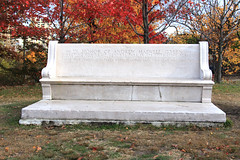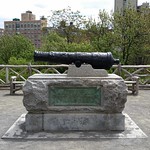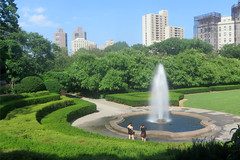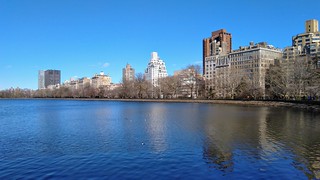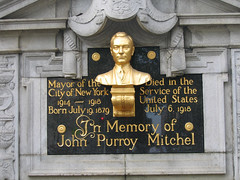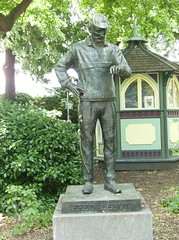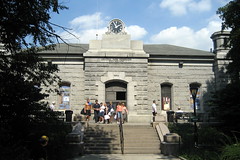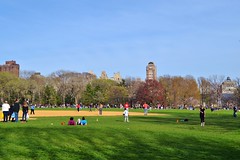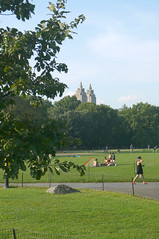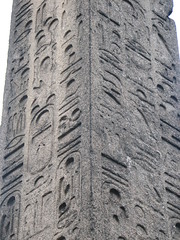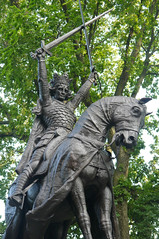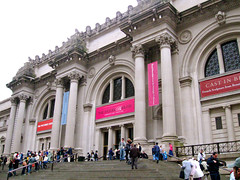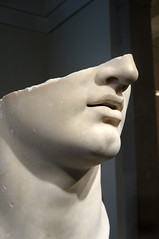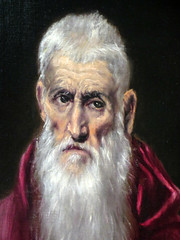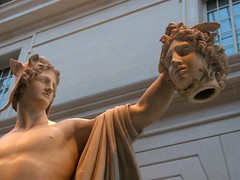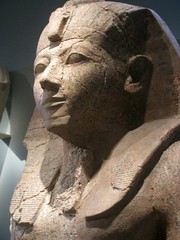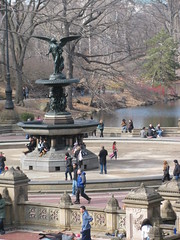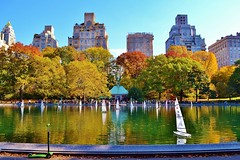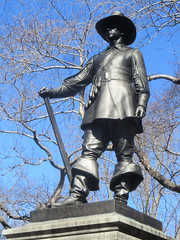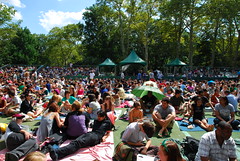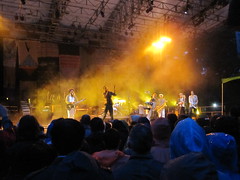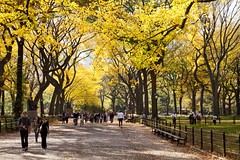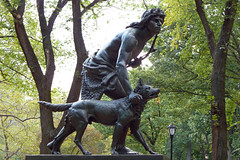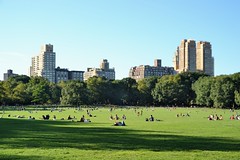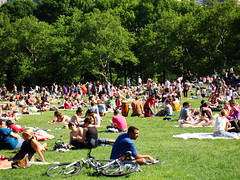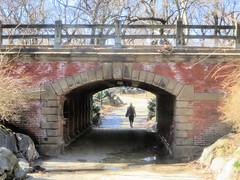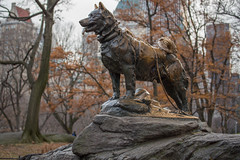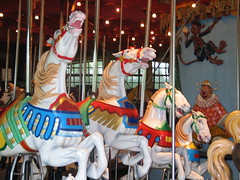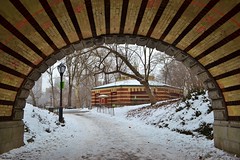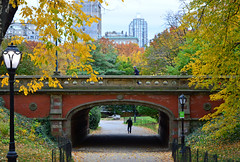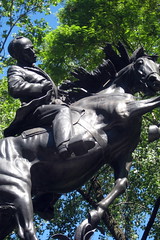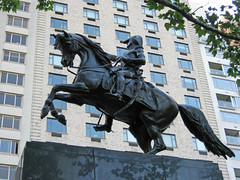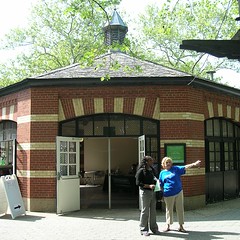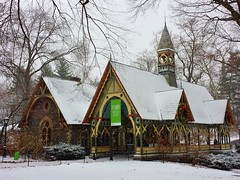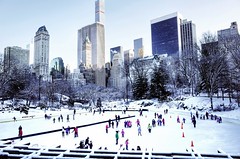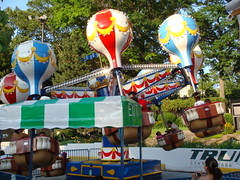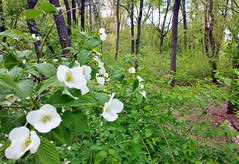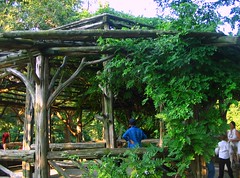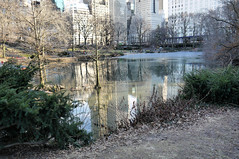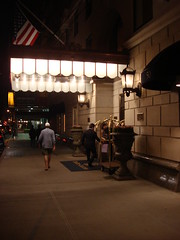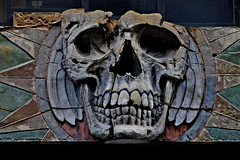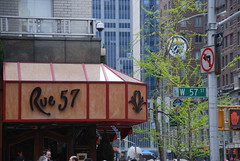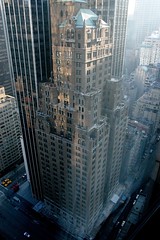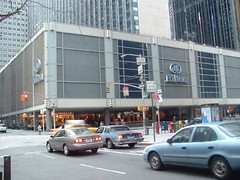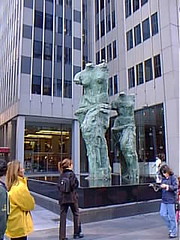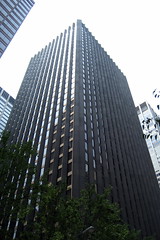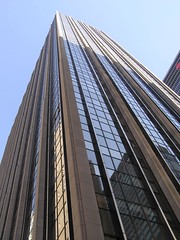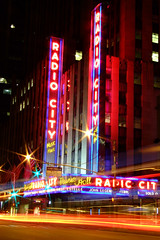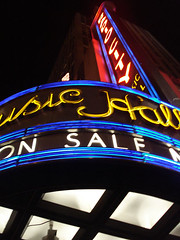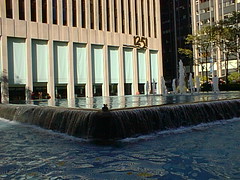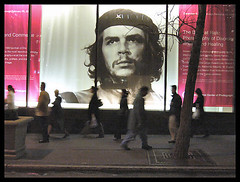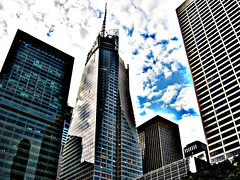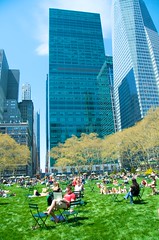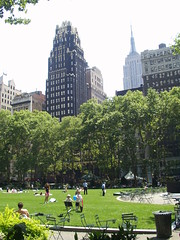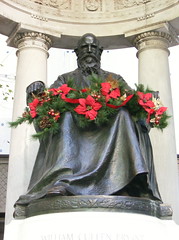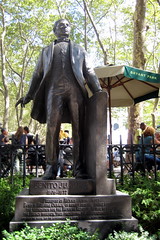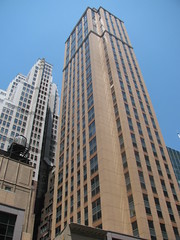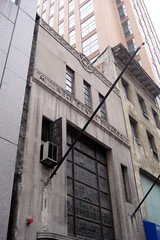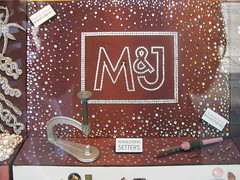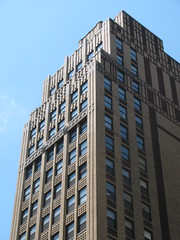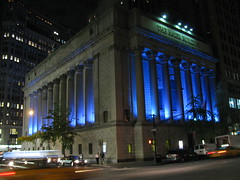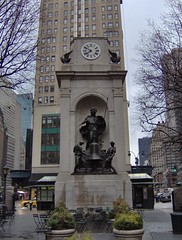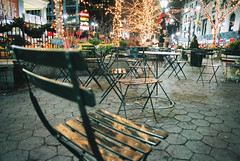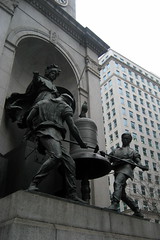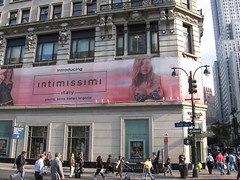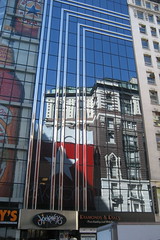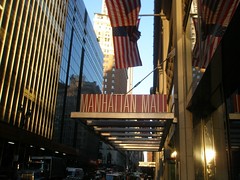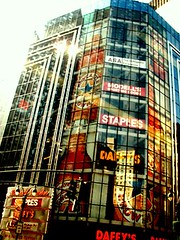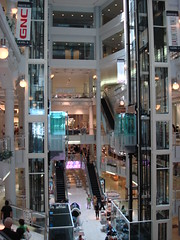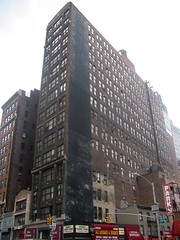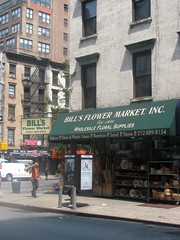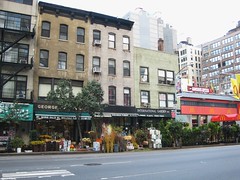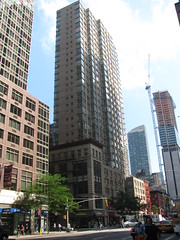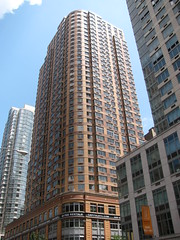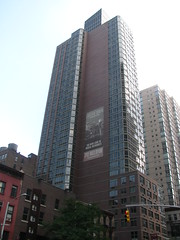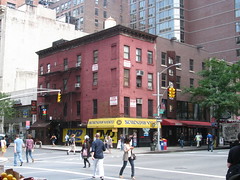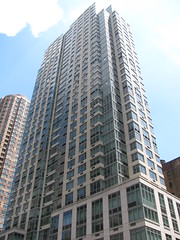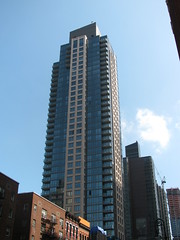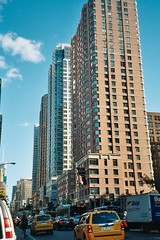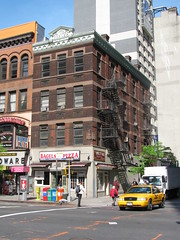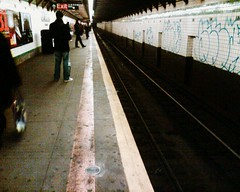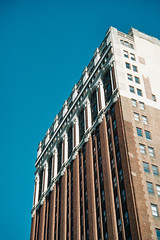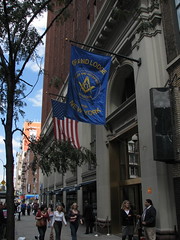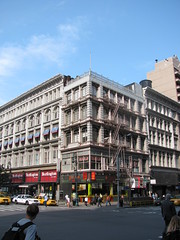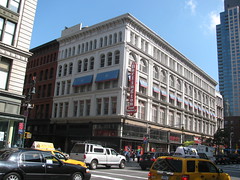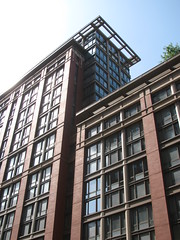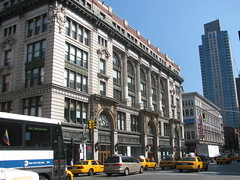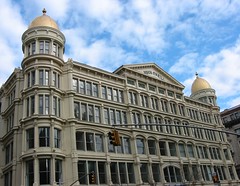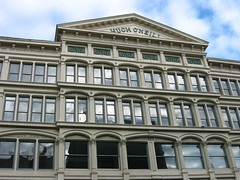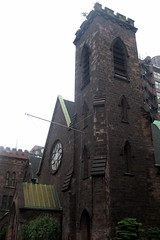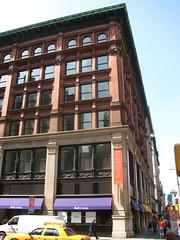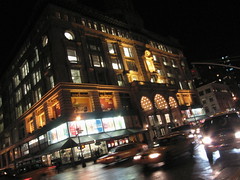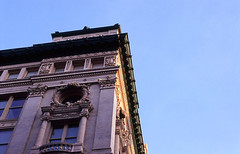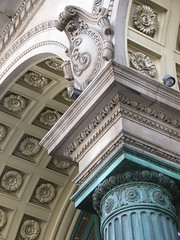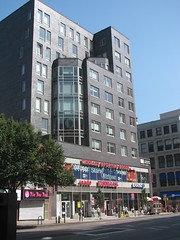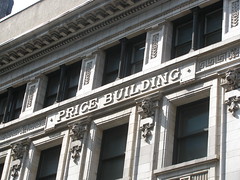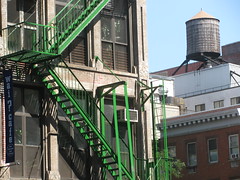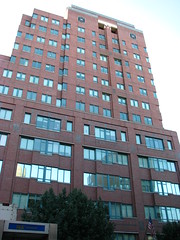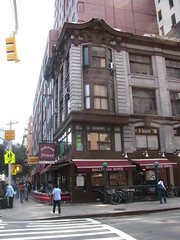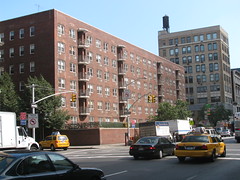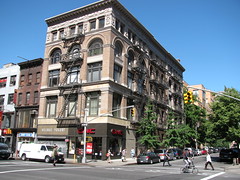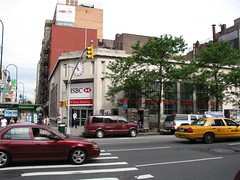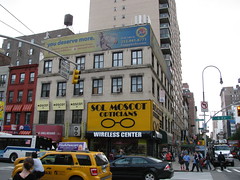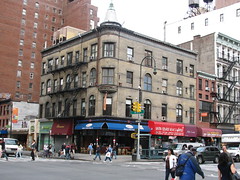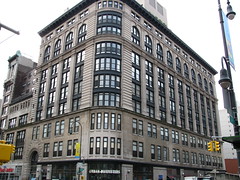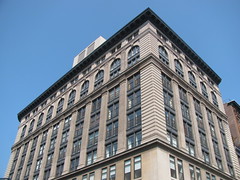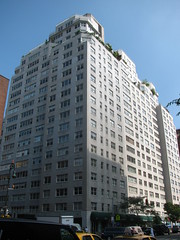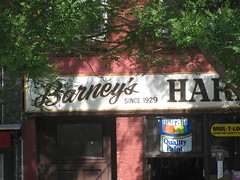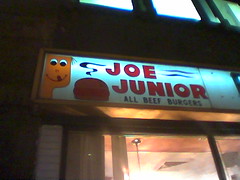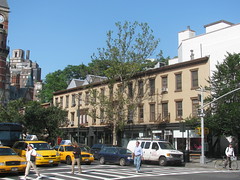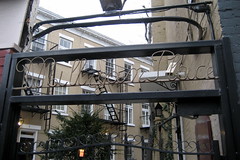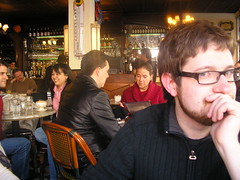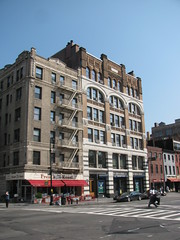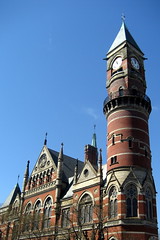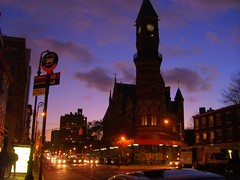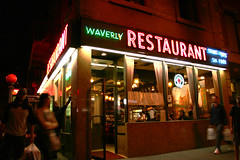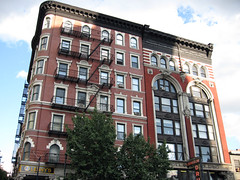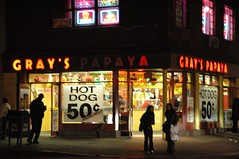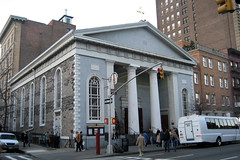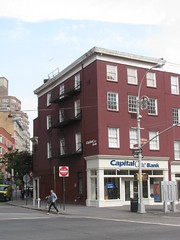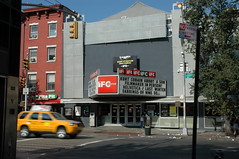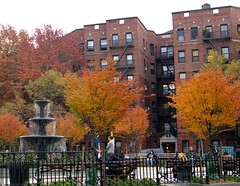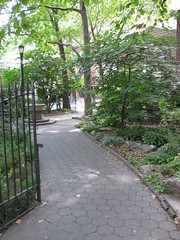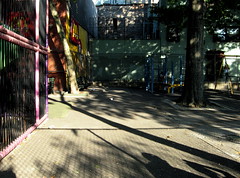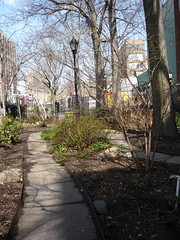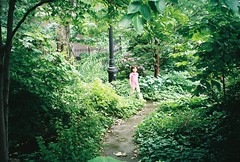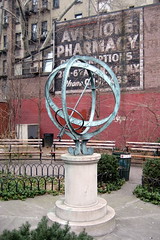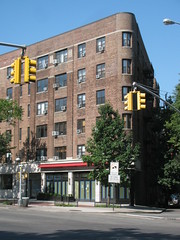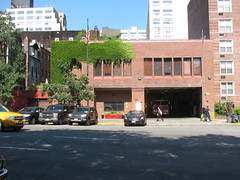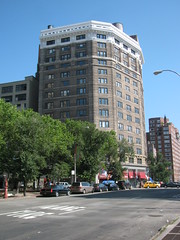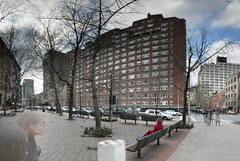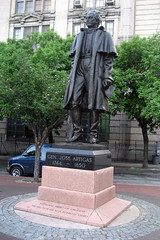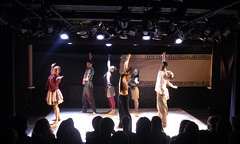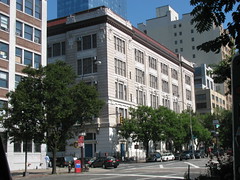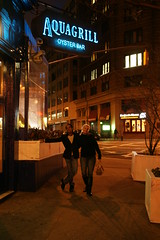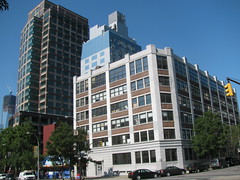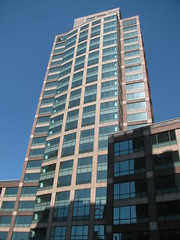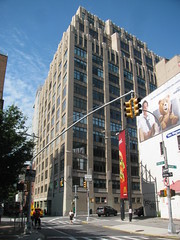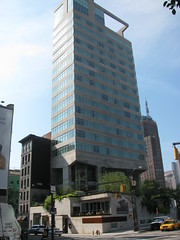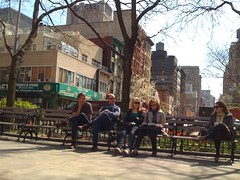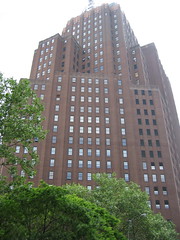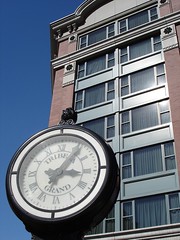West:Central Park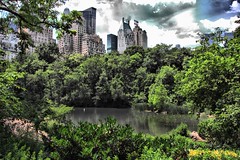
An 853- acre expanse of green in the middle of Manhattan,
its 25 million annual visitors make it the most visited
public park in the world. Responding to calls
from civic leaders like
William Cullen Bryant, the city
acquired the land in 1853 and held a design contest
in 1857, choosing the
Greensward Plan of
Frederick
Law Olmsted and
Calvert Vaux (rhymes with "Walks"). After the moving
of 3 million tons of earth and the planting of 270,000
trees and shrubs, the park—almost entirely landscaped,
despite its naturalistic appearance—opened to visitors in 1859
(though not officially completed until 1873).
|
|
The Ravine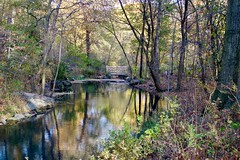 This rustic valley follows the course of Montayne�s Rivulet, a natural creek named for Dr.
Johannes de la Montagne (1595-1670), New Amsterdam's only physician in the early days of the colony. (He owned
a tobacco farm on what's now the Upper West Side.) Olmsted turned it into a long pond known as The Loch;
after a century of silting had turned it into more of a mudflat, it was restored in the early 1990s into
the more naturalistic stream seen today.
This rustic valley follows the course of Montayne�s Rivulet, a natural creek named for Dr.
Johannes de la Montagne (1595-1670), New Amsterdam's only physician in the early days of the colony. (He owned
a tobacco farm on what's now the Upper West Side.) Olmsted turned it into a long pond known as The Loch;
after a century of silting had turned it into more of a mudflat, it was restored in the early 1990s into
the more naturalistic stream seen today.
The Ravine is where Trisha Meili, better known as the Central Park Jogger, was found near death on April 20, 1989, in what became Central Park's most notorious crime. The youths charged in her assault were known as the Central Park Five; their convictions were vacated and the city paid them $41 million after DNA evidence indicated that convicted murderer/rapist Matias Reyes was the sole assailant. Donald Trump's calls for the the death penalty for the falsely accused youths helped launch his political career. Huddlestone Arch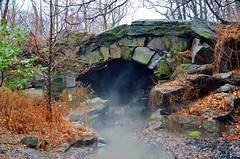 The East Drive crosses the Ravine via this Vaux-designed bridge, made of rough-cut boulders held together
only by gravity.
The East Drive crosses the Ravine via this Vaux-designed bridge, made of rough-cut boulders held together
only by gravity.
New Yorkers seem to have been quite concerned that the city would be attacked from the north
during the War of 1812, building numerous fortifications in this vicinity to guard the Boston Post Road
as it came to a pass here. A clearing here marks the site of Fort Fish, named for
Nicholas Fish (1758-1833),
chair of the Committee of Defense that was doing all of this fortifying.
|
|
North Meadow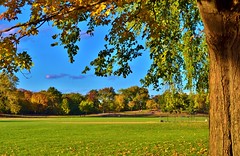 A 23-acre expanse of undulating lawn, punctuated by hillocks and rocky outcrops. There are seven baseball
diamonds, five softball diamonds (which are two-thirds as big) and five fields for soccer or touch football.
At the south end of the meadow, where there used to be stables, is now the North Meadow Recreation Center,
where you can play basketball, handball or borrow a frisbee.
A 23-acre expanse of undulating lawn, punctuated by hillocks and rocky outcrops. There are seven baseball
diamonds, five softball diamonds (which are two-thirds as big) and five fields for soccer or touch football.
At the south end of the meadow, where there used to be stables, is now the North Meadow Recreation Center,
where you can play basketball, handball or borrow a frisbee.
|
E
|
East:Farmers Gate One of the 20 gates named by the Commis- sioners of Central Park in 1862—though the names were not
actually inscribed until 1999. The names were intended to reflect the democratic intentions of the park;
I assume this particular assignment had something to do with the still rural character of the north end of
Manhattan in the 1860s.
One of the 20 gates named by the Commis- sioners of Central Park in 1862—though the names were not
actually inscribed until 1999. The names were intended to reflect the democratic intentions of the park;
I assume this particular assignment had something to do with the still rural character of the north end of
Manhattan in the 1860s.
Dana Discovery Center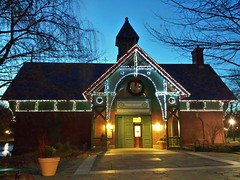
Built in 1993 but looking much older, this environ- mental and visitors center was designed by Samuel G. White—great-grandson of Stanford White—using Central Park's Victorian-styled Dairy as a model. Charles A. Dana (1819-1897) was a prominent 19th Century newspaper editor (at the Tribune and Sun) who was assistant secretary of War during the Civil War, serving as Grant's liaison to Washington. But the Center was paid for by the Charles A. Dana Foundation, founded by his son, Charles A. Dana Jr. (1881-1975)—a business executive and lawyer who early in his career helped prosecute Stanford White's killer. It's unclear whether father or son is the namesake of the Center. There was a boathouse built on this site in 1947 that had fallen into ruin by the 1970s. Harlem Meer This 11-acre lake (which is "meer" in Dutch) is the third-largest body of water in Central Park, after The Reservoir
and The Lake.
It was originally a brackish wetland at the coming-together of Montayne�s Rivulet (now The Loch)
and Harlem Creek, an inlet of the East River that no longer exists aboveground. Dredged into open water by Olmsted, it was
given a concrete shoreline by Robert Moses in the 1940s that was removed in a 1990s renovation.
This 11-acre lake (which is "meer" in Dutch) is the third-largest body of water in Central Park, after The Reservoir
and The Lake.
It was originally a brackish wetland at the coming-together of Montayne�s Rivulet (now The Loch)
and Harlem Creek, an inlet of the East River that no longer exists aboveground. Dredged into open water by Olmsted, it was
given a concrete shoreline by Robert Moses in the 1940s that was removed in a 1990s renovation.
Lasker Rink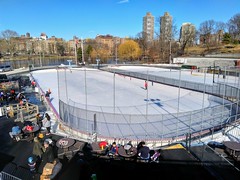 A skating rink in winter and Central Park's only swimming pool in summer, built on what was once part of the
Harlem Meer, it opened in 1966 with a Modernist
aesthetic not found in the rest of the park's infrastructure. The rink is run by the Trump Organization,
the pool by the Parks Department.
A skating rink in winter and Central Park's only swimming pool in summer, built on what was once part of the
Harlem Meer, it opened in 1966 with a Modernist
aesthetic not found in the rest of the park's infrastructure. The rink is run by the Trump Organization,
the pool by the Parks Department.
It's named for Loula Lasker (1886-1961), whose estate helped finance construction. She was a founder of the League for Industrial Democracy—best remembered as the progenitor of Students for a Democratic Society—and a vice president of the women's Zionist league Hadassah. The site of Nutter's Battery, an 1812-era fortification built on the site of a British Revolutionary War outpost (and named for local landowner Valentine Nutter), is marked by a stone circle built in 1945 and rebuilt in 2014. The East Drive passes over McGown's Pass, where the old Boston Post Road crested the high ground of
what's now the north end of Central Park. It's named for Daniel McGown, who ran a tavern nearby.
Fort Clinton is another site fortified during the Revolutionary War (by the Hessians) and later by the defenders of the city in the War of 1812. It was named in 1812 after Mayor DeWitt Clinton (1769-1828), whose championing of the Erie Canal made New York the Empire State. Today the fort is a scenic overlook, marked by two cannons salvaged from the wreck of a British warship, the HMS Hussar, in 1780. In 2013 one of the cannons was discovered to be still loaded with a cannonball and gunpowder, necessitating disarmament by the bomb squad. The MountJacob Dyckman established the Black Horse Tavern here in the 1740s; the New York Colonial Assembly met here in 1752 to avoid NYC's yellow fever epidemic. Dyckman sold the tavern in 1756 to an in-law, Daniel McGown (or McGowan), by gave the inn the name it's best remembered by: McGowan's Tavern. During the Battle of Harlem Heights in September 1776, General Cornwallis used the tavern as his headquarters. In 1786, after the war, it changed management and was known as Leggets Half Way Tavern.The tavern seems to have disappeared by 1847, when Mount St. Vincent�s Academy was built on or near the site. With the land dedicated to become part of Central Park, the Sisters of Charity-affiliated school relocated to the Bronx, where it still is found today. Frederick Olmsted lived with his family on the former school grounds from 1859-63 during the creation of the park. At that point it became the Central Park Hospital, aka the US General Hospital or St. Joseph�s Military Hospital, caring for Civil War casualties. In 1866, following the war, there was again a tavern here, known as Mt. St. Vincent�s Hotel, which burned down and was rebuilt in 1881; it was renamed McGowan's Pass Tavern in 1890 to avoid confusion with the school in the Bronx. It was torn down in 1917. Today the park runs a composting center on the site. Conservatory Garden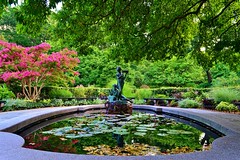 Central Park's only formal garden was originally a nursery to supply plantings for the park; later, from
1898 to 1934, it was home to a greenhouse known as the Conservatory. When the greenhouse had to be
dismantled in 1934 because it cost too much to maintain, replacing it with a garden became one of the first
efforts of the Works Projects Administration, which created more or less the current garden in 1937.
Central Park's only formal garden was originally a nursery to supply plantings for the park; later, from
1898 to 1934, it was home to a greenhouse known as the Conservatory. When the greenhouse had to be
dismantled in 1934 because it cost too much to maintain, replacing it with a garden became one of the first
efforts of the Works Projects Administration, which created more or less the current garden in 1937.
The six-acre garden is divided in three parts with distinct styles. The northern third is in the French mode, noted
for its spring tulips and autumn mums; it's centered on the Untermeyer Fountain, featuring
Walter Schott's sculpture Three Dancing Maidens.
The center portion is Italianate, showcasing flowering crabapple and wisteria. Its focus is a geyser fountain known as the Conservatory Garden Center Fountain. The southernmost section is an English-style garden with abundant magnolia and lilac. A pool here presents statues of Mary and Dickon from The Secret Garden. The wrought iron Vanderbilt Gates mark the entrance to the gardens; originally designed by George B Post for the Vanderbilt mansion at 5th Avenue and 58th Street, they were salvaged and gifted to the park in 1939 by Gertrude Vanderbilt Whitney. |
|
East:East Meadow This six-acre rolling lawn is cited as one of the success stories of the Central Park Conservancy, which
restored it from a "
forbidding dustbowl" in 2010. In the early 1970s, this was considered one of the most
dangerous areas of Central Park, with 10 percent of the 853-acre park's robberies occurring here.
This six-acre rolling lawn is cited as one of the success stories of the Central Park Conservancy, which
restored it from a "
forbidding dustbowl" in 2010. In the early 1970s, this was considered one of the most
dangerous areas of Central Park, with 10 percent of the 853-acre park's robberies occurring here.
|
